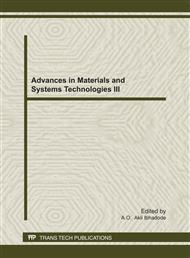[1]
Annual Reports on the Beneficial Uses of LANLOC (AMREC), as Landfill Cover Material in the Commonwealth of Massachusetts, American Reclamation Corporation, Charlton, Massachusetts, 1993-(1997).
Google Scholar
[2]
H.A. Al-Sanad, W.K. Eid and N.F. Ismael, Geotechnical properties of oil-contaminated Kuwaiti sand, Journal of Getech., Engrg., ASCE, 1995, Vol. 121, No. 5, p.407 – 412.
DOI: 10.1061/(asce)0733-9410(1995)121:5(407)
Google Scholar
[3]
F. Buchanan, A Journey from Malabar through the Countries of Mysore, Canara and Malabar East India Company, London, Vol. 2, 1807, pp.436-460.
DOI: 10.1017/cbo9780511873683
Google Scholar
[4]
L.T. Alexander and J.G. Cady, Genesis and hardening of laterite soils, US Department of Agric., Technical Bulletin, 1962, 1282, p.90.
Google Scholar
[5]
M.D. Gidigasu, Laterite Soil Engineering, Elsevier Scientific Publishing Co. New York, 1976, p.554.
Google Scholar
[6]
D.O. A Osula, Evaluation criteria for admixture stabilization of problem laterite Journal of Transportation Engineering, ASCE, 1989, Vol. 115, pp.674-687.
DOI: 10.1061/(asce)0733-947x(1989)115:6(674)
Google Scholar
[7]
R.H. Rastal, Textbook of Geology, Edward Arnold, London, England.
Google Scholar
[8]
Construction Industry Research and Information Association (CIRIA), 1988, Laterite in road pavements, Special publication 47, Transportation Road Research Laboratory, London.
Google Scholar
[9]
C.M.O. Nwaiwu, Evaluation of compacted lateritic soils as hydraulic barriers in municipal solid waste containment systems, Ph. D (Civil Engineering), Ahmadu Bello University, Zaria, Nigeria, (2004).
Google Scholar
[10]
K.J. Osinubi, Influence of Compaction Energy Levels and Delays on Cement-treated soil, Technical Transaction of the Nigerian Society of Engineers, 2001, Vol. 36, No. 4, pp.1-7.
Google Scholar
[11]
R.D. Oldham, A Manual of the Geology of India. 2nd ed. Calcutta, 1893, pp.369-390.
Google Scholar
[12]
J.W.S. De Graft-Johnson, Laterite Soils in Road Construction, Proc. 6th Reg. Conf. For Africa on Soil Mechanics and Foundation Engineering. Durban, South Africa 1975, Vol. 1: Pp89 – 98.
Google Scholar
[13]
F. Akintola, A., Geology and geomorphology, Nigeria Maps, K. M. Barbour, ed., Hodder and Stoughton, London (1982).
Google Scholar
[14]
O. Areola, Soils In: Barbours K.M. (Editor) Nigeria in Maps, Hodder and Stoughton, London, (1982).
Google Scholar
[15]
K.J. Osinubi, "Influence of compactive efforts and compaction delays on lime-treated soil, Journal of Transportation Engineering, 1998a, ASCE, Vol. 124, No. 2, p.149 – 155.
DOI: 10.1061/(asce)0733-947x(1998)124:2(149)
Google Scholar
[16]
K.J. Osinubi, Permeability of lime – treated lateritic soil, Journal of Transportation Engineering, 1998b , ASCE, Vol. 124, No. 5, p.465 – 469.
DOI: 10.1061/(asce)0733-947x(1998)124:5(465)
Google Scholar
[17]
BS 1377, Methods of testing soil for civil engineering purposes, British Standards Institute, London, (1990).
Google Scholar
[18]
J.H. Charman, Laterite in road pavements (CIRIA) Special Publication 47, Construction Industry Research and Information Association., ed., CIRIA, London, (1998).
Google Scholar
[19]
Transport and Road Research Laboratory (TRRL), Tropical soils: Formation, classification and engineering properties, Department of Environment, Her majesty's Stationery Office (HMSO), (1990).
Google Scholar
[20]
K. H Head, Manual of Soil Laboratory testing, Vol. 1. Soil Classification and Compaction, Pentech Press, London, Plymouth, (1980).
Google Scholar
[21]
F. Van Ganse Renè, Immediate amelioration of wet cohesive soils by quicklime, Transportation and Research Record, 1971, Vol. 5, p.43 – 53.
Google Scholar
[22]
K.J. Osinubi and T.S. Ijimdiya, Effect of Compactive Efforts on the Plasticity and Strength Properties of Reconstituted laterite. Nigerian Society of Engineers, Technical Transactions. Oct. – Dec. 2009, Vol. 44, No. 4. Pp. 1 – 14.
Google Scholar
[23]
T.S. Ijimdiya, Effect of Oil contamination on soil properties, Book of Proceedings 5th Nigerian Material Congress, Ile-Ife, Osun State, NIMACON 2007, November,. p.138 – 142.
Google Scholar
[24]
T.S. Ijimdiya, Effect of used oil on the compressive strength of lateritic soil, Book of Proc. Materials Society of Nigeria, Bi-monthly meetings/workshops, organized by Zaria Chapter, 2008, p.11 – 16.
Google Scholar
[25]
H.U. Rehman, S.N. Abduljauwad and T. Akram, Geotechnical Behavior of Oil-Contaminated Fine-grained Soils, Electronic Journal of Geotechnical Engineering, 2001, Ppr0720. Pp. 1-13.
Google Scholar


